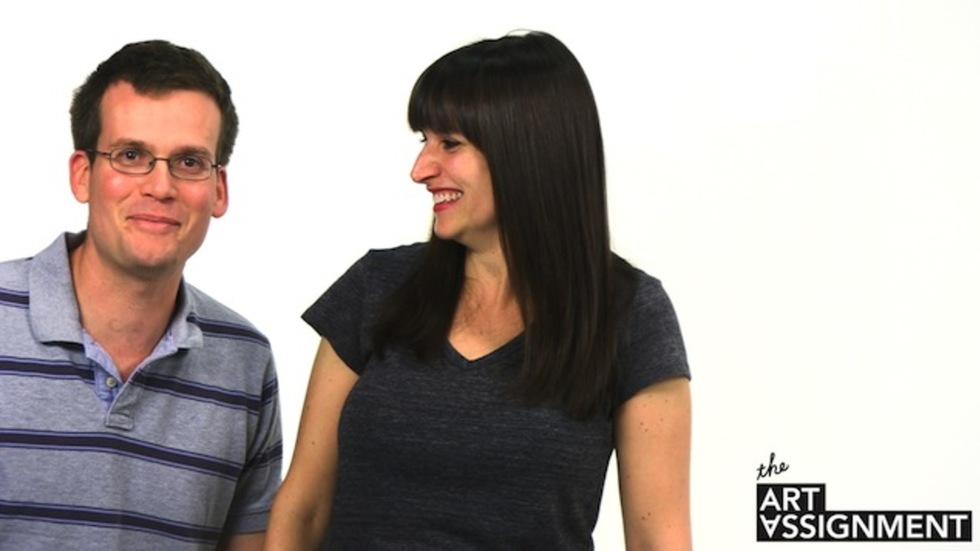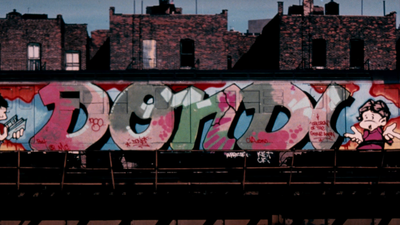
BY LINDSAY ROBERTSON |
Interview: Sarah and John Green Talk About Their New Web Series 'The Art Assignment'
Sarah Urist Green and John Green answer our questions about their exciting new show with PBS Digital Studios, The Art Assignment, which aims to de-mystify art for the internet audience (and de-mystify the internet for artists.)

Today, after several days of teasers, influential vlogger and bestselling author (The Fault in Our Stars, Looking for Alaska) John Green announced a new video project to his million-plus Twitter followers (if you don't know who John Green is yet, here's a guide to John Green Fandom 101).
The Art Assignment is a new series from PBS Digital created by and starring John's wife, museum curator Sarah Urist Green, who will travel the country visiting artists in their workspaces, with each of them offering an art assignment (make a movie poster using only clip art and comic sans; draw with your eyes closed) that is open to people who don't own traditional art-making materials.
John will tag along as Sarah's non-art-expert companion. Like everything the Greens touch, it's sure to find a large, engaged, passionate audience. We talked to Sarah and John about the new show.
Tribeca: Tell me a little about the genesis of this show. Is it something you've been thinking about for a long time? How did you come up with the audience/interactive element?
Sarah Urist Green: I kept noticing instances where internet memes - planking, old me, new me, etc - and collaborative online video projects were really not so dissimilar from early conceptual art and its contemporary predecessors. There are numerous examples in art history of artists giving themselves or others instructions as a form of art-making. I saw this overlap as a possible way of exposing the internet generations to contemporary art, and as a way of legitimizing and celebrating the enormous creative output that the internet and social media has made possible.
As I started to get more involved in social media, I couldn't help but think about the possibilities it held for exposing new audiences to art.
Also, I've been working in a museum field that is increasingly worried about its relevance and its ability to attract new and bigger audiences. I've really enjoyed getting to know my audience in Indianapolis, while also attempting to broaden that audience. But there is an inherent limit to how many people can physically travel to a museum. As I started to get more involved in social media, I couldn't help but think about the possibilities it held for exposing new audiences to art. There is already a lot of great art-related content out there, but I think there is potential for so much more.
I love the surprise of seeing how different minds approach the same problem.
The Art Assignment will also be a tool for those either in school or out of school who have little access to art and art instruction. I worry that more traditional art instruction, with too many rules and strictures, can sometimes have the effect of driving people away from art. My hope is that this series shows the incredible breadth of art today, that it can be multi-disciplinary, and that it can exist outside of museums and galleries.
Tribeca: How did your years of museum curation prepare you for this new job?
Sarah Urist Green: I've been able to meet so many artists during my time as a museum curator. That experience has been an incredibly rewarding one that I'd like to share with others. I have a broad network of artists and colleagues in the field who I'm drawing upon for the show. During my time in museums, some of my favorite moments have been presenting artists with problems and commissioning them to create works that solve them. For example, we needed a concession stand in 100 Acres, our art park, and so we commissioned an experimental Swedish architecture firm to design one for us. I love the surprise of seeing how different minds approach the same problem, and I can't wait to see what the internet comes up with in response to these artist-given challenges.
Tribeca: John, what have you learned about art from Sarah, and what excites you about this show?
John Green: When Sarah and I started dating, I read a bunch of books about contemporary art so that she would think I was smart. This effort mostly failed, but having spent the last ten years traveling around with her and hanging around during her studio visits, I've gained a deep appreciation for contemporary art. I hope through the show many thousands of people will have the experience I've had: Through visiting with working artists and getting some art historical context, hopefully lots of people will develop a new interest in, and appreciation for, the role that art can play in our lives.
This is not a high pressure situation for those responding to the assignment. Judging and winning will not be part of it.
Tribeca: I really enjoyed the art-themed reality show Work of Art on Bravo, but it put as much emphasis on the clashing of big personalities and egos than it did on the actual art. How will this show be different (it already sounds pretty different!)
Sarah Urist Green: The main difference is that our show is not at all focused on the finished product. The Art Assignment's concern is generating ideas, the creative process, and the act of making. This is not a high pressure situation for those responding to the assignment. Judging and winning will not be part of it. I will put together episodes that show what I think are some of the best viewer responses to the assignments, but I really only see that as a way of aggregating content and making it easier to find the good stuff. The "reward" will be making something cool and showing it to other people on the internet. Also, this is a PBS production. No wardrobe budget for us.
I hope that it will expose some internet-wary artists to the glory of the internet.
Tribeca: How will the artists be involved?
Sarah Urist Green: The artists will be completely responsible for coming up with the assignments, and I do think that most of them will be interested in following the viewer responses. I'm sure it will vary, but I hope that it will expose some internet-wary artists to the glory of the internet.
Tribeca: Can you tell me a few of the assignment ideas you hope to do?
Sarah Urist Green: I don't know yet! And that's the beauty of it for me. I'm looking forward to putting the audience in the hands of super talented, innovative artists and seeing what plays out. I'll work with the artists to make sure that there is a good variety of challenges, most of which I'm hoping won't involve traditional art supplies or costly purchases.
Tribeca: How did you pitch the show, and what was that process like?
John Green: PBS reached out to my brother and me and asked if we had any ideas for shows that would be a good fit for them. We really like what PBS is doing with their digital studios, and in many ways PBS is ahead of traditional networks when it comes to merging the broadcast and online worlds, because while most networks are driven by a desire to get the most possible views, PBS has always prioritized content that has PASSIONATE viewers who will support shows directly. That's the model we think is going to work online.
But anyway, Hank and I had some ideas, but nothing that really worked. So we reached out to friends and family and asked them if they had ideas. Sarah developed and pitched The Art Assignment directly to PBS, and they were immediately excited by it. Then it was just a matter of working out a budget and all that stuff.
Sarah Urist Green's The Art Assigment will premiere in early 2014. Subscribe to the show's YouTube channel for updates.

